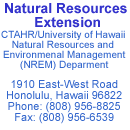


|
|
||||||||||||||||||||||||||||||||
| Project Name: | Pearl Harbor Watershed Environmental Restoration Projects |
| ASO Log No.: | YO-375 |
| Start/End Date: | April 2000 to December 2001 |
| Federal Funds: | $55,000.00 |
| Matching Funds: | $55,000.00 |
| Contractor: | Joseph Chernisky |
| Background/ Overview: |
The threats stemming from rapid urbanization and natural pollution are readily apparent to water impairment in Pearl Harbor. Noticeable are commercial and household use and disposal of chemicals discharged into storm drains, agricultural discharge and soil loss, mangrove overgrowth, loss of permeable soil cover, and storm water discharge from streets, oil, and sewage spills. Lack of planning and stewardship, civilian and military development projects, and urban pollution and population growth through the Pearl Watershed are endangering the area’s natural and cultural resources. |
| Objectives/Goals: | To reduce nonpoint source pollution caused by urbanization by surveying and monitoring the impact of urban growth and implementing Best Management Practice (BMPs) such as field surveys, clean-ups, and erosion and sediment control structures. |
| Methods Employed: | The project was successful in partnering with 25 stakeholders within the Pearl Harbor watershed. These partners include Advanced Educational Systems, Ahupuaa Action Alliance, Aiea Community Association, Aloha United Way, Belt Collins, Kahi Mohala Hospital, Leeward Lions, Malama Hawaii, Mililani Girls Scouts, Nakamura Gakuen University and Junior College, Oahu Mauna Kilo Cultural Mapping, Ocean Conservancy/Sea Grant, Pearl City Benchmarking, Pearl Harbor Historic Trail, St. Francis School for Girls, The Nature Conservancy, US Navy and US Air Force, and US Fish and Wildlife Services. The project was successful in completing 102 site visits, field trips, and surveys. During the site visits, 46 water quality samples were taken from Waiawa stream to West Loch to gather background information on the watershed. Parameters included temperature, depth, salinity, dissolved oxygen, pH, and chlorophyll a. Overall, the site visits and surveys verify the substantial impairment of Pearl Harbor from increased population, homeless and urban growth patterns, highway outfalls, traffic, loss of permeable surfaces, and vegetative overgrowth. The project also conducted 20 clean up events resulting on the removal of over 1500 bags of litter and debris. Participation in the project came from 800 volunteers. |
| Pollutants of Concern: | Suspended solids, chlorophyll, pesticides, PCBs, dioxins, furans, turbidity, |
| Watershed: | Pearl Harbor Waterbody Segment consists of 10 subwatersheds: Manuwai, Halawa, Aiea, Kalauao, Waimalu, Waiawa, Waipio, Kapakahi, Waikele, Honouliuli, and Kaloi, island of Oahu |
| Size of Project: | Not described in report |
| Affected Water Bodies: | Pearl Harbor |
| Deliverables: | None described in report |
